Have you ever heard of headless commerce? If not, don’t worry, you’re not alone. In spite of its growing popularity in recent years, many people are still unfamiliar with this new ecommerce approach. So, what is headless commerce exactly mean?
In short, it is a contemporary approach to building and managing ecommerce websites that allow for enabling increased adaptability and customization.
Here Are Some FACTS Related To Headless ECommerce:
- Mordor Intelligence’s report states that the headless ecommerce market was worth $1.06 billion globally in 2020 and is projected to expand at a CAGR of 22.8% from 2021 to 2026.
- BigCommerce survey found that 57% of ecommerce businesses are planning to invest in headless commerce in the next two years.
- 451 Research found report that 34% of ecommerce businesses are using or planning to use headless architecture.
- According to a study by Algolia, headless ecommerce websites have a 50% faster time-to-market for new features and updates.
- Contentful survey found that 90% of businesses that have adopted a headless architecture report an increase in their website speed.
- Gartner report stated that by 2022, Headless has been shown to increase conversions, and businesses that have adopted a headless architecture will see a 30% increase in digital business revenue.
- Skava study found that headless commerce can reduce website development time by up to 40%.
These statistics & trends demonstrate the growing popularity of headless ecommerce, as businesses seek to improve their ecommerce functionality and provide a seamless user experience.
In this article, we’ll explore the ins and outs of what is headless commerce exactly.
What Is Headless Commerce

Headless commerce is explained as a modern ecommerce approach that enables businesses to decouple the front-end of their online store from the underlying infrastructure. This separation allows businesses to modify and customize the front-end without impacting the back-end, resulting in increased agility and flexibility. Essentially, it provides the freedom to design unique user experiences and interface designs without constraints imposed by the back-end systems.
How Does Headless Commerce Works
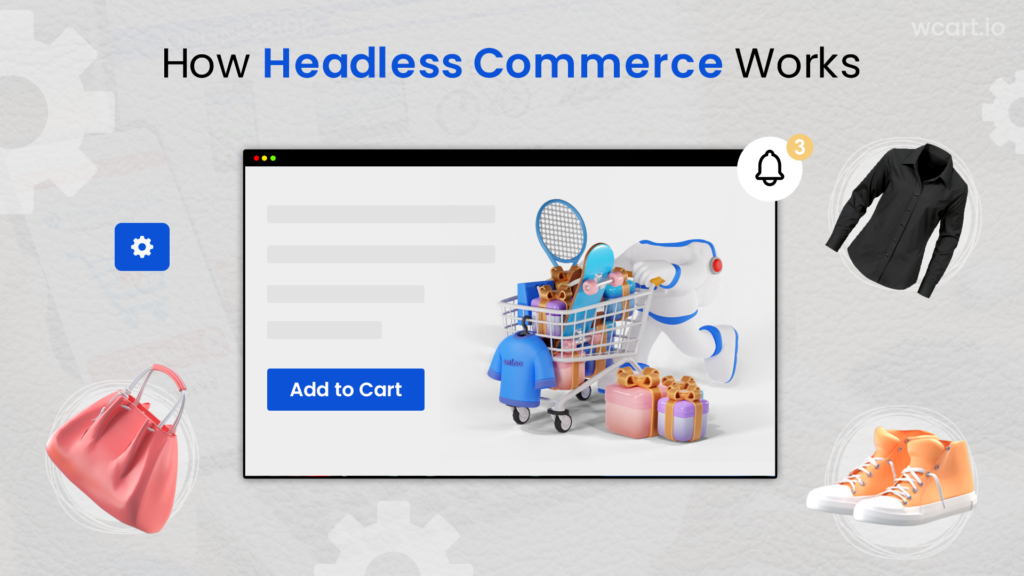
Headless commerce works effectively by separating the front-end and back-end aspects of an ecommerce system. This segregation empowers businesses to make alterations to the front-end without causing any disruptions to the back-end functionalities. To accomplish this, headless commerce leverages an API-first architecture, microservices, and content management systems.
Visit Here: How Does Headless Commerce Works?
Headless Commerce Architecture Explained
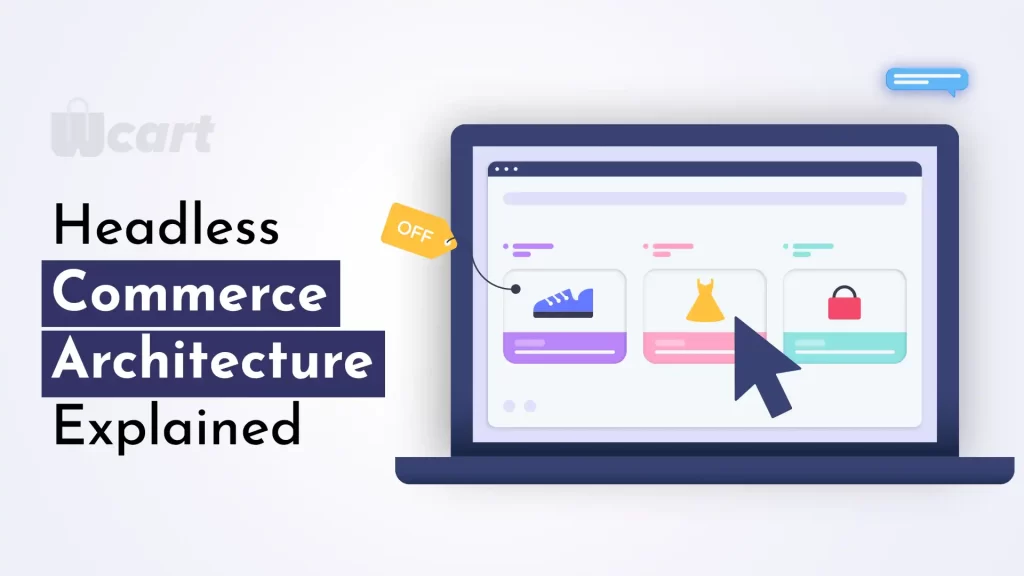
Headless commerce architecture includes a front-end, back-end, and connecting APIs. The front-end layer can be customized independently, offering businesses increased flexibility and agility.
1. Headless Commerce API-First Approach and its Benefits

In headless, an API-first approach separates both front-end and back-end, allowing for greater flexibility and customization.
Some benefits of an API-first approach in headless commerce include:
- Greater Flexibility: By decoupling these components, modifications can be made to one without impacting the other. This flexibility allows for quick and rapid changes to the website as a whole.
- Customization: Adopting an API-first approach provides developers with a higher degree of control over the front-end presentation layer. This level of control enables greater customization possibilities and unique branding opportunities. Developers can tailor the user interface to match specific design requirements and create a distinctive user experience.
- Scalability: By keeping the front-end and back-end separate, modifications to the back-end can be made independently of the front-end. This separation enables easier scaling and adaptation of the website’s infrastructure to accommodate increasing traffic and evolving business needs.
Visit Here: Benefits Of Building Ecommerce Microservices Architecture
2. Headless CMS and its Role in Headless Commerce
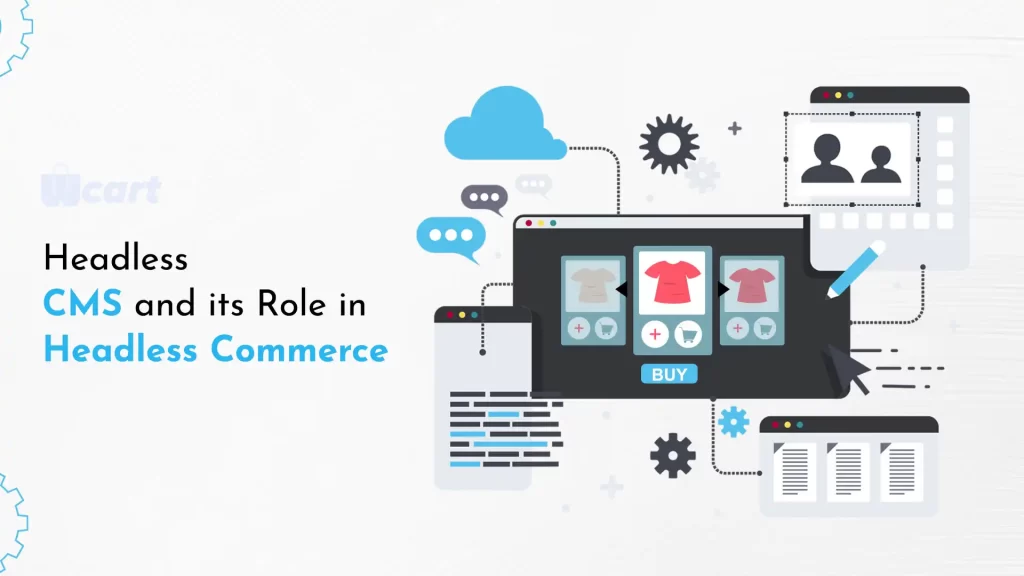
A headless CMS is a system that separates the management of content from front-end. This decoupling brings about several advantages in terms of managing and delivering content across different channels and devices.
- Better content management – Allows greater flexibility in managing content across every channel and device, making it easier to deliver relevant content to customers.
- Greater customization – Developers have more control over the front-end presentation layer, allowing for wider customization and unique branding opportunities.
- Easier integration – Easily integrate with other systems and tools, such as analytics and personalization tools, to provide a seamless customer experience.
Read More: Discover the Best Ecommerce CMS for Your Online Store
3. Headless Ecommerce Platforms and Their Features

A software platform provides back-end commerce functionality, such as payment processing and order management, without the front-end.
Some features of headless ecommerce platforms include:
- Scalability: Designed to be highly scalable, allowing for easy expansion as the business grows.
- Customization: Provide a high level of customization, allowing for unique branding and customer experience opportunities.
- Integration: Easily integrate with other systems and tools, such as CMS and analytics tools, to provide a smooth customer experience.
Read More: Understanding Headless Commerce Architecture: How It’s Built
Top 4 Headless Commerce Benefits
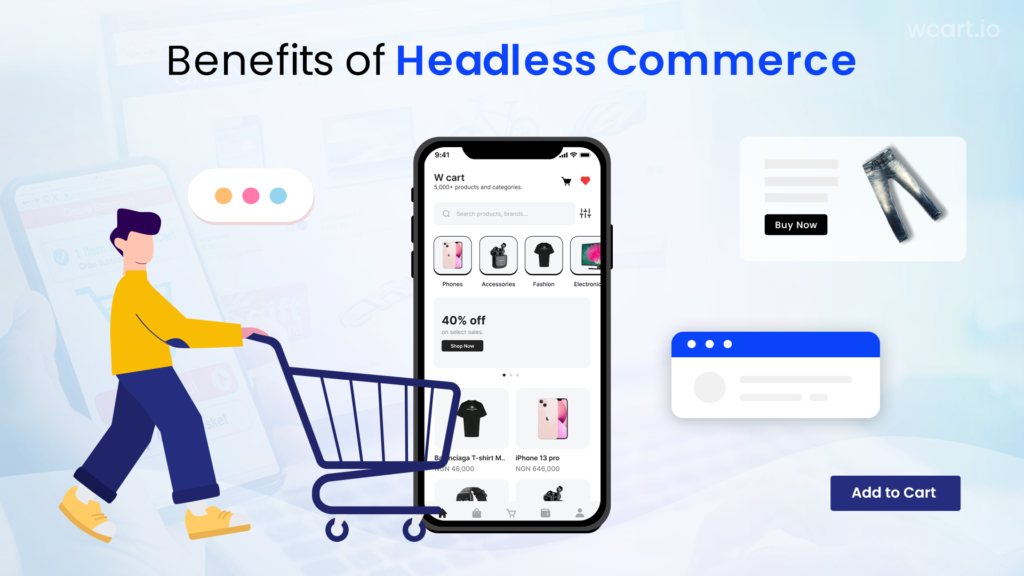
1. Enhanced flexibility and scalability
By decoupling the front-end and back-end, businesses gain more freedom to customize the design and functionality of their front-end experiences. Also, this flexibility allows them to create tailored user interfaces that align with their brand image and cater to their specific target audience.
Furthermore, businesses can effortlessly introduce new front-end experiences and expand their omnichannel presence without being constrained by backend limitations. This scalability empowers businesses to adapt to the changing demands of their customers and remain competitive in the market.
2. Better customer experience
By utilizing the decoupled architecture, businesses can deliver a personalized smooth customer journey across various touchpoints. Leveraging data and analytics, they gain insights into customer behavior and preferences, allowing them to optimize the experience accordingly.
Additionally, headless ecommerce enables businesses to achieve faster page load times and improved performance. This translates into an enhanced user experience, reducing bounce rates and increasing the likelihood of conversions. Ultimately, these improvements in customer experience contribute to higher revenue generation for businesses.
3. Improved website performance and speed
Headless ecommerce with its separation of front-end and back-end components, enables businesses to independently optimize each element. This leads to faster page load times and enhanced website performance. By prioritizing speed, mobile responsiveness, and user engagement, businesses can improve their search engine rankings and drive increased traffic to their website.
4. Increased efficiency in managing and updating content
With a decoupled architecture, content creation, and management can be centralized in a single location, enabling easy distribution to multiple touchpoints. Also, this eliminates the need for manual updates and ensures consistent content across all channels. This streamlined approach saves time and effort, allowing businesses to focus on delivering high-quality content to their customers.
Read More: Unveiling the Benefits of Headless Ecommerce
3 Major Drawbacks of Headless Commerce
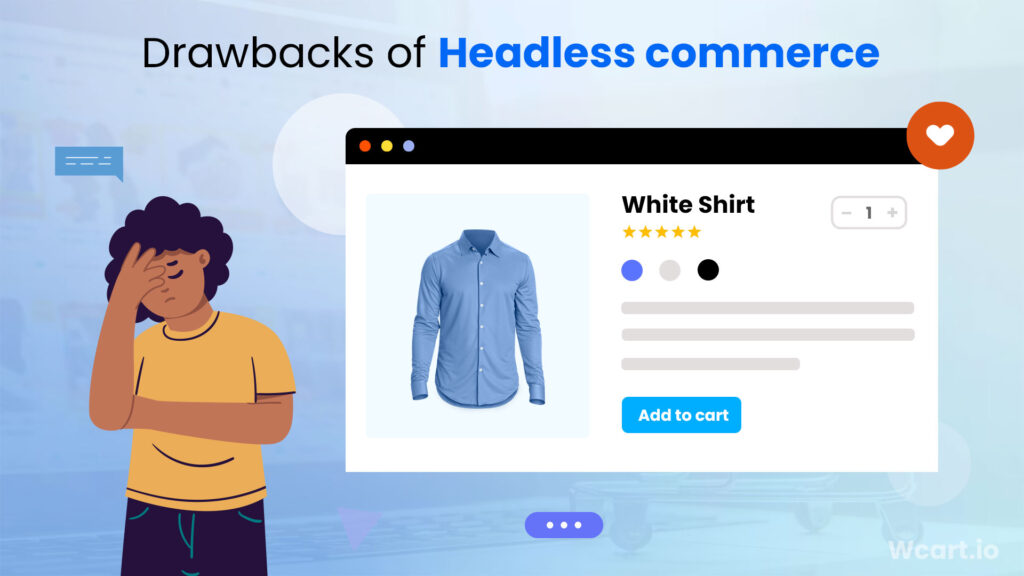
With several benefits, it also has some drawbacks that businesses need to consider. One of the primary drawbacks is the complexity of implementation. Headless requires businesses to have a deep understanding of the technology and architecture, which can be time-consuming and costly.
1. Complexity in implementation
Ensure that the components work logically together since the front-end and back-end are decoupled. Significantly this requires a high level of technical expertise and can be challenging for businesses without an in-house development team.
2. Requires technical expertise
Solid understanding of the technology and architecture to ensure seamless integration between the front-end and back-end components. Specifically, this can be challenging for businesses without an in-house development team and may require hiring external experts.
3. Higher initial costs
Since businesses need to build their own custom front-end experiences, the upfront investment can be significant. In addition, businesses need to ensure that their infrastructure and technology can support the decoupled architecture, which may require additional investment in hardware and software.
Differences Between Headless Commerce and Traditional Commerce
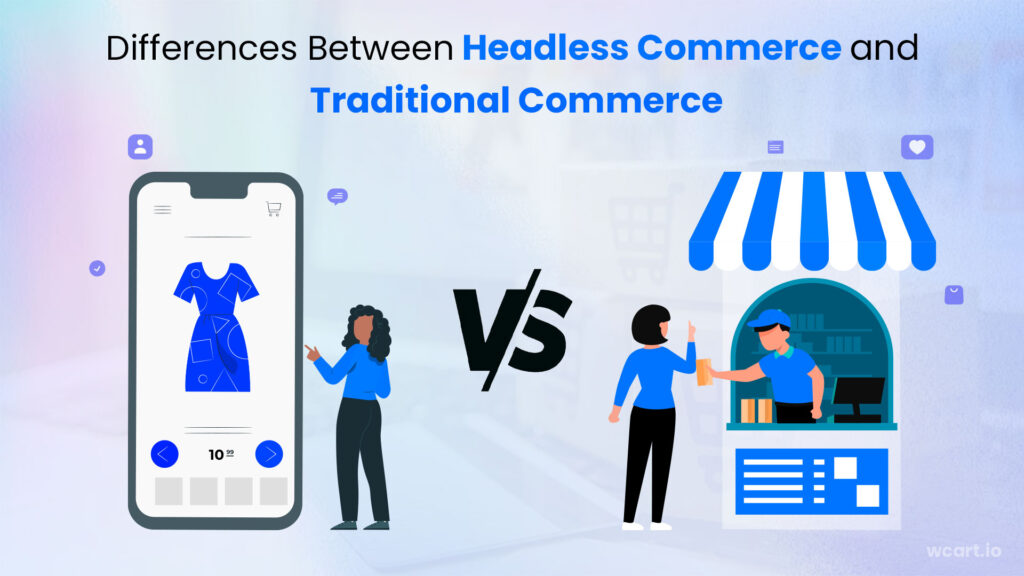
Headless commerce differs from traditional commerce in several ways, including architecture, design, and functionality.
Key differences between traditional and headless Ecommerce
- Design: Traditional ecommerce has limited design flexibility, while headless ecommerce allows for custom front-end experiences.
- Architecture: Traditional ecommerce has a monolithic architecture, while headless ecommerce has a decoupled architecture.
- Functionality: Traditional ecommerce has limited functionality, while headless ecommerce enables businesses to add new features and touchpoints easily.
Read More: Ultimate Guide to Building a Ecommerce Website from Scratch
Step-by-Step Guide for Implementing Headless Ecommerce

Here is a step-by-step guide for implementing headless ecommerce that requires careful planning and execution
1: Define your business requirements and goals.
2: Choose a headless ecommerce platform that suits you well.
3: Develop your custom front-end experiences using APIs and SDKs platform.
4: Integrate front-end with back-end using the APIs platform.
5: Test and optimize the system for performance and scalability.
Factors to Consider Before Implementing Headless Commerce
- Technical expertise: Businesses need to have the technical expertise to implement and manage a headless commerce system.
- Budget: It can be expensive, with higher upfront costs than traditional commerce.
- Infrastructure: Businesses need to ensure that their infrastructure and technology can support the decoupled architecture.
- Scalability: Enables businesses to scale quickly, but they need to ensure that the system can handle the increased traffic.
Who Should Use Headless Commerce
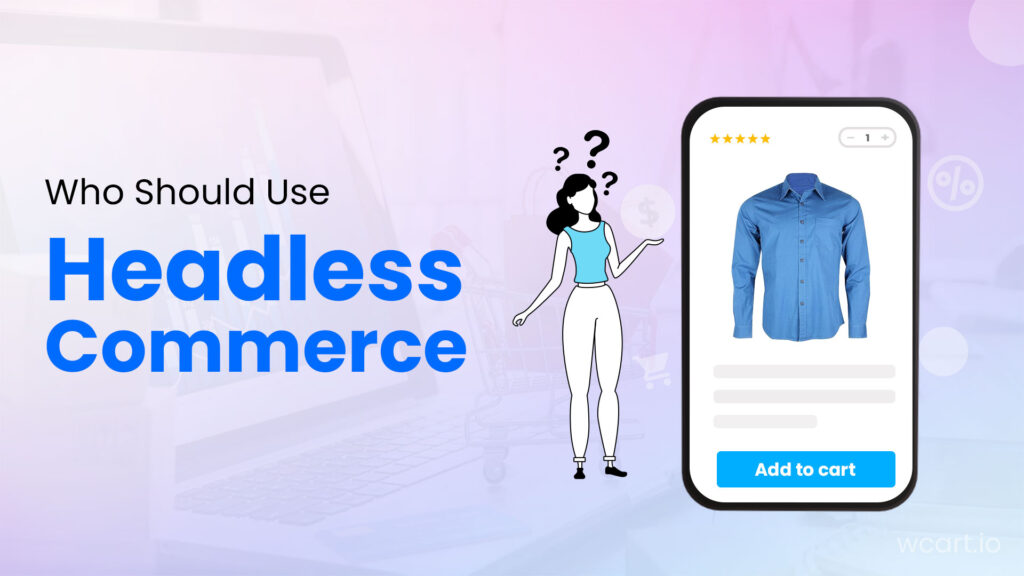
It is ideal for businesses that require flexibility, scalability, and custom front-end experiences. It is particularly suitable for businesses that want to create personalized and seamless customer journeys across multiple touchpoints.
Industries and businesses that can benefit from headless commerce
- Retail: Enables retailers to create custom front-end experiences across multiple channels and touchpoints, providing a personalized and seamless customer journey.
- Hospitality: Enable hotels and restaurants to create custom booking experiences and personalized offers for customers.
- Financial Services: Helps financial services companies to create custom experiences for customers across multiple touchpoints, from mobile banking apps to online portals.
How Headless Commerce Can Help Small and Large Businesses
Small businesses can use reduce development costs and improve website performance, while larger businesses can take advantage of its scalability and flexibility. It enables businesses to easily customize ecommerce solutions that fit their specific needs, whether they want to expand into new markets, launch new products, or create personalized customer experiences.
Read More: Comprehensive Guide to E-Commerce Website Development
Headless Commerce Best Practices That Businesses Should Keep
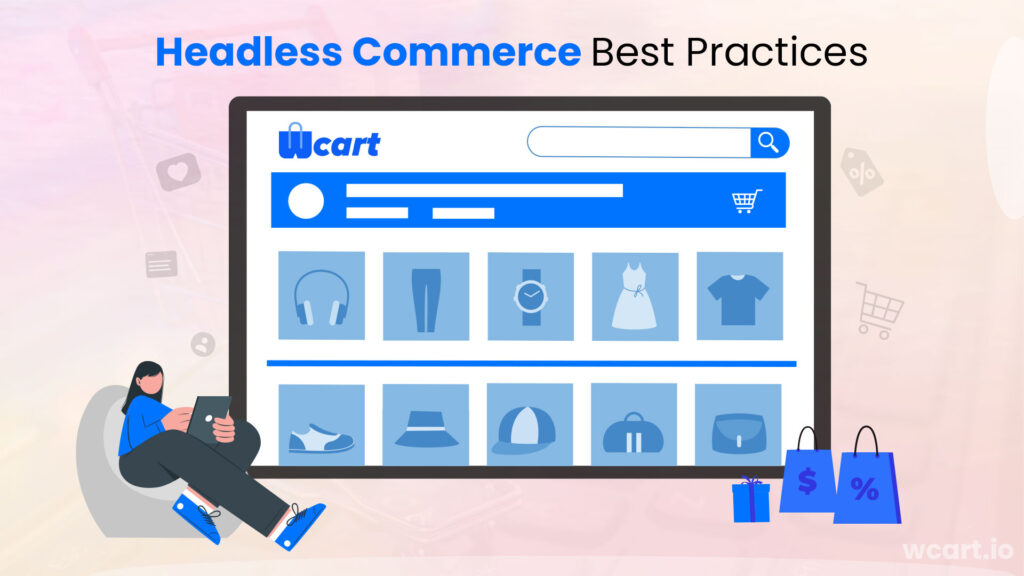
When implementing, there are several best practices that businesses should keep in mind.
- First, it is important to select the right headless commerce platform for your business needs.
- Requires careful consideration of factors such as the platform’s features, scalability, and cost.
- Additionally, businesses should prioritize the use of an API-first approach, which allows for greater flexibility and customization.
- Other best practices include implementing a headless CMS, optimizing website speed and performance, and leveraging data to improve customer experiences.
Tips and Tricks for Implementing and Managing Headless Commerce
Implementing and managing headless commerce can be challenging, but there are several tips and tricks that businesses can use to streamline the process.
- One key tip is to involve all relevant stakeholders early on in the implementation process, from IT and development teams to marketing and customer service.
- Additionally, businesses should prioritize testing and experimentation to ensure that their headless ecommerce solution is meeting their business goals.
- Other tips include regularly monitoring website performance, staying up to date with industry trends, and leveraging third-party integrations to enhance functionality.
Common Mistakes to Avoid When Implementing Headless Commerce
There are several common mistakes that businesses should avoid when implementing.
- Failing to properly plan for the implementation process, which can lead to delays and cost overruns.
- Selecting the wrong headless commerce platform, failing to properly test and optimize website performance, and neglecting to involve all relevant stakeholders in the implementation process.
Headless Commerce Case Studies
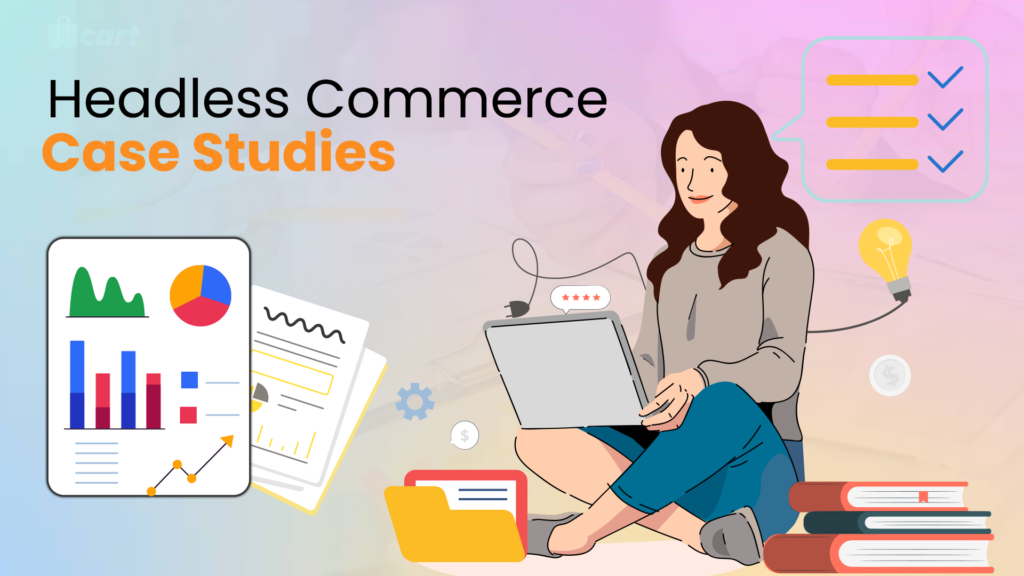
Real-life examples of businesses that have successfully implemented can provide valuable insights for businesses considering this approach.
- For example, the cosmetics retailer implemented Wcart headless commerce to improve website performance and provide a more personalized customer experience.
- Another example is the fashion retailer, which used Wcart headless commerce to create a more seamless online and offline shopping experience for customers.
The Future of Headless Commerce
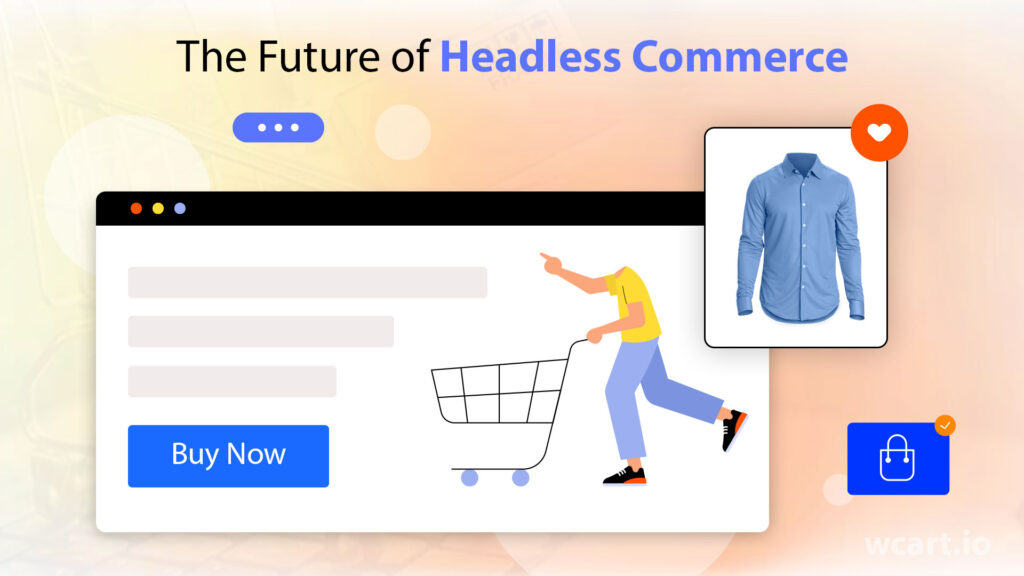
One major trend is the continued rise of mobile commerce, which is driving increased demand for headless commerce solutions that can deliver smooth and personalized experience for all devices and channels. Other trends include the rise of voice commerce and the increased importance of data and analytics.
Conclusion
In conclusion, as explained headless commerce offers businesses a powerful and flexible solution to enhance performance, scalability, and customer experience. To ensure successful implementation and management, businesses should carefully assess their technical expertise, budget, and available resources. Prioritizing performance and speed is crucial, as they have a significant impact on customer experience and search engine rankings. Moreover, Wcart headless ecommerce team is available to provide assistance and keep businesses updated on the latest trends and developments, allowing them to leverage its full benefits.
Frequently Asked Questions (FAQs)
1. What is the difference between headless commerce and traditional ecommerce?
Unlike traditional e-commerce, headless commerce separates the frontend and backend, enabling greater flexibility and customization options.
2. How does headless commerce improve the customer experience?
Headless commerce allows businesses to deliver personalized and consistent experiences across all channels and devices, increasing customer satisfaction.
3. Is headless commerce more expensive to implement than traditional ecommerce?
Implementing headless commerce costs vary depending on factors like chosen platform and customization requirements. However, the long-term benefits often outweigh the initial investment.
4. Can headless commerce integrate with existing systems and tools?
Yes, headless commerce can integrated through APIs, allowing for seamless data flow and interactions.
5. Are there any risks or challenges associated with adopting headless commerce?
Headless commerce offers numerous benefits, but challenges may arise during implementation, experienced Wcart professionals help will reduce the risks during the need for technical expertise and coordination between frontend and backend teams.
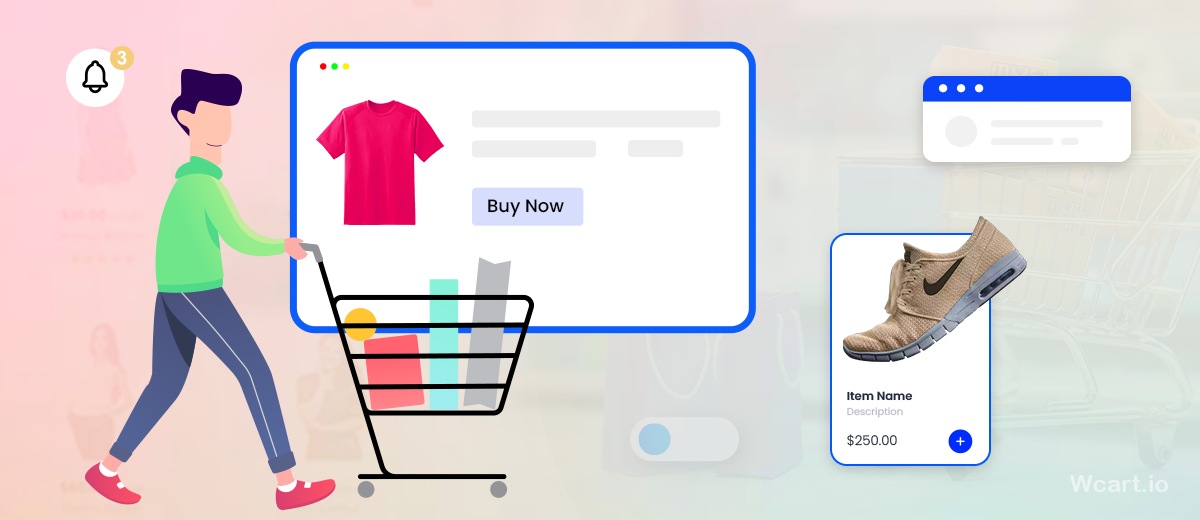



Leave a Reply